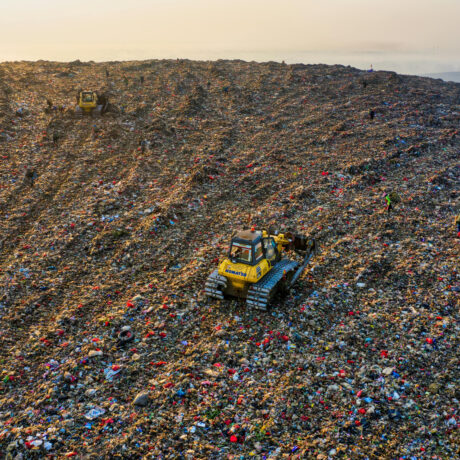What’s In My School Uniform?
The UK government has said it wants all pupils back at school in the autumn, but there is uncertainty as to what children will be permitted to wear. Blazers and ties, which can’t be washed every day, may be banned to reduce the spread of Covid-19 and an affordable uniform bill currently going through Parliament would require schools to offer unbranded choices in order to reduce costs. This follows the statutory guidance introduced in Wales last year to make school uniforms more affordable, accessible and gender-neutral.
As parents’ thoughts turn to back-to-school, Fashion Revolution warns that the chemicals found in school uniforms could prove a risk to children’s health. In Europe, around 15,000 chemical formulations are used in textile production[i] and it takes between 10% and 100% of the weight of the fabric in chemicals to produce that fabric.[ii] Many of these chemicals are found in our clothing, including pesticides, dyestuffs & pigments, crease-resistant agents, oil & water repellents and antibacterial agents. The skin is the body’s largest organ and, since it is porous, it can absorb harmful chemicals which then enter the blood stream.
School uniforms are frequently advertised as stain-resistant, non-iron or easy-care, but many of the chemicals designed to make uniforms easier for parents to launder are known to be damaging to human health and to wildlife. After evidence of serious health problems from the use of PFOA, used by DuPont to make Teflon, a coating frequently used to make school clothing stain and water repellent, came to light, it was phased out under a voluntary agreement and in May last year more than 180 countries agreed to ban its production and use under the international Stockholm Convention on Persistent Organic Pollutants (POPs). It is known that PFOAs remain in the body for a long period of time and have been found in almost everyone in the world and even in penguins and polar bears.
The next generation of chemicals, known as PFAS (Perfluoroalkyl and Polyfluoroalkyl Substances), may be a regrettable substitute as evidence from the US Environmental Protection Agency (EPA) suggests their effects are just as bad or even worse than the chemicals they have replaced. PFAS chemicals are not only harmful to wildlife and the environment, but there are probable links to tumors and cancer, liver and kidney function, hormone disruption and reduced immunity.[iii] The US based Agency for Toxic Substances and Disease Registry reports that this is an area of particular concern during the current Covid-19 pandemic as studies suggest that exposure to PFAS may reduce antibody responses to vaccines and may reduce resistance to infectious diseases. More research is needed to understand how PFAS exposure may affect illness from COVID-19. [iv]
Even when clothing doesn’t come directly into contact with the skin, such as blazers and outerwear, it can still have significant health implications. One survey found that “the drying and storage of winter clothing indoors in schools and institutions may possibly in the worst case cause significant indoor air exposures …thereby contributing to the health problems that can result from the combined exposure to PFASs”.
Although these chemicals should mean that school uniforms last longer and need to be washed less frequently, a study concluded that the chemicals actually made no difference to parents laundering and purchasing habits, which raises the fundamental question of whether they are needed on our clothing in the first place.[v] Moreover, current government guidance is to wash school uniforms on a daily basis.
Formaldehyde is another chemical that has been used in clothing for decades due to its ability to reduce wrinkling and is widely found in school uniforms that are advertised as easy-care or non-iron. When it comes into contact with the skin, formaldehyde can cause rashes and allergic reactions[vi]. Formaldehyde, along with disperse dyes which are typically used to colour synthetic yarns and fabrics[vii], is being cited as one of the chemicals which caused some airline staff to become highly allergic to their uniforms, resulting in over 500 Delta employees filing a class-action lawsuit against the uniform manufacturer earlier this year. Although formaldehyde eventually washes out of clothing, studies have found that there is no reduction in formaldehyde levels after two washes. Delta employees claim they were still suffering allergic reactions a year after they received their new uniforms[viii].
Fashion Revolution’s Fashion Transparency Index was released in April 2020 and included 250 of the world’s biggest brands and retailers, including all of the major UK high street school uniform retailers. 60% of the brands in the Index weren’t publishing a Restricted Substances List, so there is often no way of knowing what chemicals are, or aren’t, permitted to be used in the manufacture of school uniforms.
Parents can be a powerful force to bring about change. Ask #whatsinmyclothes to let brands and retailers know we don’t want materials which compromise children’s health and nature’s ecosystems, and request that your school offers chemical-free options if there is no choice of retailer. Writing to your local MP to encourage support for the school uniform bill will also help to ensure a wider choice of uniforms are made available to all parents.
The first step when buying a new school uniform is to see how much is disclosed about the coatings and treatments used, either in the product description section of the website or on the garment label in store. For parents on a tight budget, this is a rare case where the best option can also be the money-saving choice as school uniforms which are not sold as non-iron, stain-resistant, water-repellent or easy-care tend to be cheaper and are offered by many retailers[ix]. Parents who children have a pre-existing skin condition like eczema or dermatitis may want to choose an organic option. Fashion Revolution also recommends buying second-hand school uniform as the more a garment has been washed, the more likely it is to have shed most or all of its chemicals. Where there is no option but to buy new school uniforms with chemical treatments, they can be soaked for a day in a bucket with baking soda. Alternatively, adding white vinegar to the wash cycle will also to help remove formaldehyde. Ideally,the clothing should then be line-dried for a day before being worn[x]
Ask #WhatsInMyClothes? Click here for our free printable posters and learn more about asking brands and policymakers ‘What’s in my clothes?‘ in our digital activism guide.
[i] https://www.sgs.com/en/news/2017/07/aiming-for-zero
[ii] Jain 2017 https://scientificresearchjournal.com/wp-content/uploads/2017/06/Home-Science-Vol-4_A-623-633-Full-Paper.pdf
[iii] https://www.epa.gov/pfas/basic-information-pfas
[iv] https://www.atsdr.cdc.gov/pfas/health-effects/index.html?CDC_AA_refVal=https%3A%2F%2Fwww.atsdr.cdc.gov%2Fpfas%2Fhealth-effects.html
[v] https://www.pfasfree.org.uk/wp-content/uploads/FidraUniformSurvey_Report_Final.pdf
[vi] https://onlinelibrary.wiley.com/doi/full/10.1111/j.1600-0536.2009.01582.x
[vii] https://link.springer.com/article/10.1007/s40521-019-0197-5
[viii] https://www.theguardian.com/business/2019/apr/03/delta-flight-attendants-uniforms-rash-claims
[ix] https://www.ethicalconsumer.org/fashion-clothing/stain-resistant-school-uniforms
[x] https://www.wikihow.com/Remove-Formaldehyde-from-Clothing#:~:text=Allow%20your%20clothes%20to%20off,may%20be%20in%20your%20clothes.










